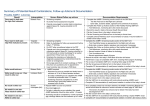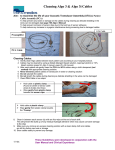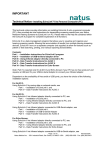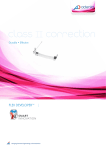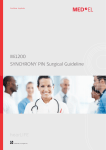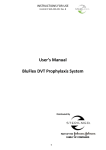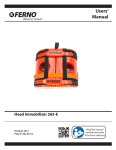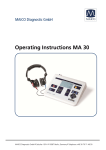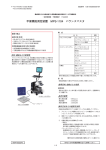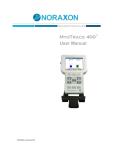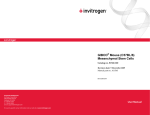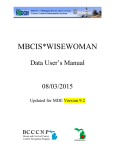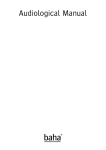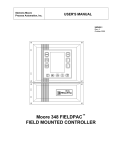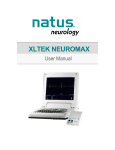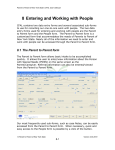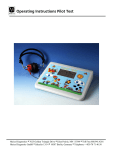Download Protocol and Guidelines Appendices 1
Transcript
Appendix 1: Healthy Hearing Glossary of Terms Term Explanation/Description AABR 1 AABR 2 The first hearing screen performed where a Refer or Pass result is obtained for both ears. The second hearing screen performed following a Refer outcome in one or both ears on the first (AABR1) screen where a Refer or Pass result is obtained for both ears. Audiological/Targeted Surveillance Babies who receive a Pass result for both ears on their first (AABR1) or second (AABR2) hearing screen but who present with the risk factors for delayed onset or progressive hearing loss listed on the Healthy Hearing Screening & Referral form require referral to Audiology for comprehensive assessment before they reach 12 months corrected age. Equals the chronological age in weeks minus time born before 40 weeks. Is undertaken using an Algo 3 or Algo 3i device using Automated Auditory Brainstem Response (AABR) technology. Brain wave responses are automatically measured and interpreted as a Pass or Refer response. Will only detect a hearing loss sufficient to interfere with speech & language development, not whether hearing thresholds are within normal limits. Is not diagnostic, just identifies individuals who require further assessment. Only diagnostic tests (audiological & medical) can confirm the presence of a hearing loss. Only indicates whether hearing is adequate for the development of normal speech and language skills at the time of screening. Babies who are at least 34 weeks gestational age & preferably < than 3 months corrected age & who have no significant craniofacial abnormalities; are in an open crib; off ventilators; & are not receiving central nervous system stimulants (eg caffeine), ototoxic medications or phototherapy for hyperbilirubinaemia. Babies can be screen up till 6 months corrected age in some situations Midwife, Registered Nurse or Enrolled Nurse who has completed an approved education program and achieved competencies in performing universal newborn hearing screening using the Algo 3 and/or 3i. AINs are not eligible to be trained to perform hearing screens. In some circumstances, hearing screening may also be performed by Indigenous Health Workers who have undertaken an approved training program. Only indicates that hearing is adequate at the time of screening for the development of normal speech and language. It does not indicate that the baby can hear at normal levels or guarantee that the baby’s hearing will not change over time. A slight hearing loss could still be present and hearing can change over time so ongoing parental monitoring using the Hearing and Speech Checklist is essential. Requires a minimum of 1000 sweeps. Only indicates that further assessment (second screen or diagnostic Audiology) is required. Does not indicate that a hearing loss is present, though it is important to acknowledge that this is one possibility. Is when there have not been 1000 matching responses to the template analysed within the AABR technology and the device has completed at least 15,000 sweeps. A procedure applied to a non-selected population to identify those who require diagnostic assessment. Advantage of screening is the identification of individuals who would not otherwise be suspected of having a problem. Screening results are not diagnostic: they only indicate the possibility of a condition being present or absent. Cycle where the Algo generates a click & collects baby’s response. Corrected age Healthy Hearing Screening Medically suitable Nurse screener Pass result Refer result Screen Sweep List of Abbreviations AABR: automated auditory brainstem response HLRF: hearing loss risk factors ABR: auditory brainstem response PCHL: permanent childhood hearing loss CP: Clinical Pathway PHL: permanent hearing loss FSF: Family Support Facilitator PHR: Personal Health Record Book HH: Healthy Hearing QHLFSS: Queensland Hearing Loss Family HHP: Healthy Hearing Program HL: hearing loss Reviewed: September 2013 Support Service S&R Form: Screening and Referral Form Appendix 2: Healthy Hearing Forms Below is a summary of the forms used by the Healthy Hearing Program. Followed by samples of these forms and guide to completing the Healthy Hearing Screening and Referral Form. Translated versions of the Consent Form in various languages is available on the Healthy Hearing Website for printing at http://www.health.qld.gov.au/healthyhearing/pages/trnsltdcnsnt.asp Title Target Group Parent/s of all babies who give Healthy Hearing Program Consent Form consent or decline the hearing screen Reviewed: August 2013 (Review: 2015) Purpose Medico-legal document for recording: o Parent/s understanding of the hearing screen & any risks associated with having/not having screen o possible use of the results including recording in the data base, research & notification to other health professionals o parent/s consent/decline of hearing screen Title Target Group Healthy Hearing Program To be completed for all babies regardless of Newborn Hearing Screening & Referral Form whether they commence/complete the hearing screen process Purpose Medico-legal document used to: o record demographic & medical data including presence of high risk indicators for hearing loss o record results & follow-up actions of screen for filing in babies’ clinical charts o refer baby to Audiology & Family Support Service o provide a template for data entry into Algo o any additional information re screening history Guide to Completing the Healthy Hearing Screening and Referral Form (S&R Form) The Healthy Hearing Screening & Referral Form (S&R Form) is completed for all live births regardless of whether or not the baby completes the hearing screen. This form services several purposes including: Collects demographic information Records relevant medical history: for example, the presence of specified risk factors for delayed onset or progressive hearing loss Template for entering data into the relevant fields on the screen of the Algo 3 or 3i Referral form to Audiology for immediate diagnostic assessment Referral form to Audiology for follow-up assessment if specified risk factors identified Referral form to the Queensland Hearing Loss Family Support Service (QHLFSS) following a Refer result on the second screen (AABR2) Documentation record of the hearing screen results and follow-up actions. The Baby’s Details and High Risk Indicators are completed by referring to the medical charts (maternal and neonatal) rather than by asking the mother or family. The chart provides a more reliable source of information, protects patient confidentiality. The exception is when collecting information on Family history of permanent childhood hearing loss. This will usually require discussion with the parent/s or the family as this aspect of medical history is often not well documented in the medical record. Where a baby dies or is transferred for medical reasons before the hearing screen process is commenced, high risk indicators can be left blank. If a baby’s family declines the screen or fails to attend scheduled screening appointment/s then all sections of the form except screening results are to be completed and filed in the baby’s chart. Revised: August 2013, (Review: 2015) The Additional Notes section on the reverse side of the form can be used to record any additional information regarding the hearing screen history. Baby’s & Mother’s Details Affix the Baby’s Patient Identification Label and the Mother’s Identification Label in the designated boxes on the form. Alternatively, the details can be hand written on the form if no stickers are available. Facility/Service Enter the name of your hospital. This information is important if a referral is made to Audiology or QHLFSS – correspondence to the referring hospital can occur on outcomes of appointments and follow –up provided. Alternative Contact Details Complete the 2 Alternative Contact Details sections to assist with arranging initial or follow-up appointments if the family can not be contacted. If possible, this should be someone other than the mother’s partner. Medical Contact Enter name and address of the Family GP, Paediatrician or Medical Centre. Information can be obtained from the chart in the first instance but should be confirmed with the parent/s at the time of the screen. A letter will be sent to the family’s doctor if the parent/s cannot be contacted to arrange an appointment for a hearing screening or if they miss more than 2 scheduled appointments without notification. Algo Fields & Baby’s Details The Healthy Hearing Program is required to collect some mandatory data fields and these are entered into the data fields on the Algo 3 and 3i screening devices. UR Number (Medical Record Number field) Record the UR Number of where the hearing screening is being performed. If the AABR2 is attended at a different facility to AABR1, record the UR number of where AABR2 is being performed. The Healthy Hearing database will link the two different UR numbers when the data is downloaded. The baby’s current UR Number will also be listed on the baby’s ID label on the form. Hospital of Birth (Birth Location field) Refer to the approved list of hospital codes and record the code for the facility where the baby was born. BBA and Homebirths, Overseas and interstate births should be entered as OTHER.. Gestational Age at Birth (Other field) Record only the whole number of weeks completed on the form. For example: if gestational age is 38 weeks and 6 days, 38 is to be recorded. Location of Screen (Comments field) Tick one of the approved codes. The location reflects the current care level of the baby rather than where the screen is being performed. Refer to table below for explanation of codes. Enter the selected code in the Comment field on the Algo 3. Abbreviations refer to the level of care at the time the hearing screen is being performed: CODE MAT INTERPRETATION General Maternity Ward ICN Intensive Care Nursery, Intensive Care Unit, Neonatal Intensive Care Unit SCN Special Care Nursery BC Birth Centre, birth suite, birthing department, birthing unit, labour wards BC encompasses all locations where a baby may birth in a hospital. OPD Outpatient – at an Outpatient Clinic, or completed as an outpatient following discharge PAED Paediatric Ward or Children’s Hospital as a transfer or readmission COMM Community –residence, community health, or other settings outside of the hospital OTHER Only entered if none of the other codes are applicable Indigenous Status Number Code (Paediatrician field) Tick the appropriate code number box. Enter the number in the Algo 3 in the Paediatrician field. The family should be asked “Will this baby identify as being Aboriginal or Torres Strait Islander?” 3i Details Entered Tick this box when the additional information has been entered. The additional data is required to be entered manually. Revised: August 2013, (Review: 2015) High Risk Indicators A baby who is identified with a high risk indicator during the screening process is at risk of developing a late onset or progressive hearing loss is referred to Audiology for comprehensive diagnostic assessment before 12 months corrected age. If you tick Yes to any one of the risk factors listed, the baby must be referred to Audiology on completion of screening for a Target Surveillance assessment before 12 months of age or within 6 weeks on completion of screening for Early Surveillance risk factors. Early Surveillance risk factors are indicated by the asterisk*. The Healthy Hearing Screening and Referral Form is used to initiate the referral to Audiology by fax, scanning or copy in the mail. A medical practitioner may refer a baby directly for diagnostic audiology. The Clinician override/medical exclusion box is ticked in the Baby not screened section and the referral sent to Audiology. A medical practitioner may refer a baby for Target Surveillance outside of the Healthy Hearing Risk Indicators by utilising the Professional Concern Option. All relevant details should be documented on the Screening and Referral form and be processed by the Healthy Hearing Team. Should a clinician have concerns regarding a baby’s hearing thresholds prior to a scheduled appointment a referral will need to be initiated outside of the Healthy Hearing Newborn Screening Program by the treating clinician. Record any relevant details. Use the Notes page if more space is required. Family history of permanent childhood hearing loss (mother/father/siblings of baby only) excluding grommets/ear infection / trauma This does not include hearing loss due to injury, childhood ear infections and the insertion of grommets in the eardrum (tympanic membrane). Clarification can be sought from Paediatrician or Audiologist when uncertain if a reported hearing loss meets the required definition. Questions that you can ask to confirm whether the hearing loss was a permanent childhood hearing loss include: • Was the hearing loss associated with ear infections? • Was the hearing loss associated with an injury or accident? • Did the hearing loss occur before the family member reached school age? • Was the hearing loss permanent or did hearing improve over time? • Does/did the family member wear a hearing aid/s? • Does the family member have any trouble with their speech? *Syndromes associated with hearing loss (Early Surveillance) There are more than 400 syndromes associated with hearing loss. Some of the more common ones include the following: Refer to Appendix 6 Syndromes Associated with a Hearing Loss in the Healthy Hearing Program Protocols and Guidelines for a more detailed list. à Brachio-otorenal à Charge association à Chromosomal abnormality: eg Down Syndrome Trisomy 13/18 Turner’s Syndrome à Foetal Alcohol Syndrome à Goldenhar à Klipper-Feil à Stickler à Treacher-Collins à Usher à Noonan’s à Waardenburg à Nager à Osteogenesis Imperfecta Tick Yes if the baby has been diagnosed with any one of these syndromes or if they are suspected of having one of these syndromes. If a baby has been diagnosed with a syndrome other than those listed above and you are unsure if it is associated with progressive or delayed onset hearing loss, check with the baby’s doctor/paediatrician. Prolonged ventilation for more than 120 hours with IPPV, CPAP, HHFNCT Tick Yes if the baby was ventilated for 120 hours or more with Intermittent Positive Pressure Ventilation (IPPV), Continuous Positive Airway Pressure (CPAP) or Humidified High Flow Nasal Cannula Therapy (HHFNCT). Record the number of hours. Bacterial Meningitis (confirmed or suspected) Tick Yes if the baby has a confirmed history of bacterial meningitis or is suspected of having had bacterial meningitis. Record any relevant details. Severe asphyxia at birth Revised: August 2013, (Review: 2015) Tick Yes if the baby has a history of severe asphyxia at birth resulting in a sequelae characterised by convulsions, Hypoxic Ischaemic Encephalopathy (HIE) or Persistent Pulmonary Hypertension of the Newborn (PPHN), Intraventricular Haemorrhage (IVH), Periventricular Leukomalacia (PVL). Record any relevant details. *Craniofacial Abnormalities (Early Surveillance) Tick Yes if the baby presents with any craniofacial abnormalities of the head, face or neck: eg - cleft palate, Record any relevant details. If the only craniofacial abnormality is a cleft lip or skin tags then tick the No box. Hyperbilirubinemia Tick Yes only if levels reached or exceeded 450µmol/l for a term baby or 340 µmol/l for a preterm baby. Record the maximum SBR level. Proven congenital infection Tick Yes if the baby has a history of infection with toxoplasmosis, rubella, Cytomegaly Virus or herpes confirmed by results of urine and blood analysis of the baby, or if the baby is suspected of having syphilis. If the mother or baby was suspected of having one of these infections but the baby has since been confirmed as negative, then tick No. Syphilis may take a series of tests before the result is confirmed. If results are not yet available, enter U (unknown) in the Algo and hold the form until the results are available. The local Healthy Hearing coordinator will amend the form & database when the results become available. Professional concern/other major medical concerns A clinician may request Target surveillance for reasons that differ from the protocol. In this situation, tick Yes for Professional Concern and record the relevant details. Note details on the form. Enter this information into the Healthy Hearing database as there is no field for this item on the Algo. AABR1 Screening Results On completion of the AABR1 document the; date, time, screen outcome and tick the milestones, monitoring and or otitis media discussed box and sign in the AABR 1 section. A label may be attached if still used in the facility.AABR2 Screening Results On completion of AABR2 document the; date, time, screen outcome and tick the milestones, monitoring and or otitis media discussed box and sign in the AABR 2 section. A label may be attached if used in the facility. If the baby receives a Refer result on one or both ears, the screener must send a copy of the form via fax to the relevant Audiology service immediately to initiate diagnostic assessment. The S&R form is also to be faxed to the Queensland Hearing Loss Family Support Service. Baby not screened or screen incomplete Tick the appropriate box if a baby does not have a AABR1 or screening process is incomplete. If a parent declines a hearing screen it is essential to discuss milestones, parental monitoring and Otitis Media where the parent/s has declined the offer of a hearing screen. If the baby has been transferred, tick the box, record the name of the receiving facility and enter the date that the baby was physically transferred to another hospital. Follow up Actions Tick the appropriate boxes to indicate specific action taken. If the baby is to return for an outpatient appointment, enter the date and time. Result reversal is the unusual scenario where one ear has a Pass and the other ear a Refer or N/A result in the first screen (AABR1) and then the opposite ears Pass and Refer or N/A result in the second screen (AABR2). A third screen will be required in this situation. • Tick the box to show AABR3 is required. • Record the results of the AABR3 in the designated AABR3 section on page 2. If an information letter is sent to the baby’s GP or other clinician, indicate to whom the letter was sent. Tick the appropriate reason for the letter and record the date that the letter was sent. A copy should be placed in the clinical notes. Referral Process If the baby if being referred to Audiology, record the name/location of the clinic. Tick if the reason is for immediate diagnostic assessment or surveillance. Record the date that the referral was sent to Audiology. Revised: August 2013, (Review: 2015) Record the date and time of the Audiology appointment, if known. Record the date the referral was sent via fax to the Family Support Service. If your facility requires Medical Superintendents signature for referral to Private Audiology, tick the Med Super signature for Private Audiology box and arrange for the form to be signed and dated. A copy of the S&R form should be sent to Audiology immediately so the appointment process is not delayed. Page 2 (reverse side of the form) Baby’s & Mother’s Details Affix patient identification labels if using page 2. This is important in case the form is copied or faxed to another provider at any time. AABR3 Screening Results If the baby does require AABR3 following a result reversal (flip flop) document the screen result. A label may be attached if still used in the facility in the additional note section. If a baby obtains a Pass result on the AABR3, then milestones, parental monitoring and Otitis Media should be discussed/reinforced with the parent/s. Tick the box when this task has been completed. If the baby receives a Refer result on one or both ears, the screener must send a copy of the form via fax, or mail to the relevant Audiology service immediately to initiate diagnostic assessment. The screening and referral form is also to be faxed to the Queensland Hearing Loss Family Support Service. Additional Notes For some babies additional notes may need to be made regarding the screening process. Use the Additional Notes section for this purpose. Failure to attend appointments. Attempts to contact parent/s to arrange appointments. Advice sought by medical practitioners, audiologists or others regarding high risk indicators etc. AABR3 screening result can be completed on this page. Any extra Notes pages should be filed with the original Healthy Hearing Screening and Referral Form in the baby’s medical record. Revised: August 2013, (Review: 2015) Appendix 3: Summary of Potential Result Combinations, Follow-up Actions & Documentation Possible AABR 1 outcomes Result Interpretation Screen Status/Follow up actions Documentation Requirements Pass result in both ears: No High Risk Indicators Bilateral Pass Screening complete No further formal assessment required Parents encouraged to monitor baby’s milestones against Speech & hearing checklist on HH brochure Complete the AABR1 Screening results section of the S&R form o Tick the Pass box for the Right and Left ears o Enter date, screener details, signature and comments if necessary Complete the Follow up Actions section of the Healthy Hearing S&R form o Tick Milestones, monitoring &/or otitis media discussed Record the result in baby’s Personal Health Record Book File the Consent form in the baby’s clinical chart File the Screening and Referral form in the baby’s clinical chart Complete Clinical Pathways (CP) documentation (if used) or record notation in mother’s &/or baby’s charts Pass result in both ears: High Risk Indicator/s present Early/Targeted Surveillance Complete the AABR1 Screening results section of the S&R form o Tick Pass/Refer boxes as appropriate for the Right and Left ears o Enter date, screener details, signature and comments if necessary Complete the Follow up Actions section of the Healthy Hearing S&R form o Tick Milestones, monitoring &/or otitis media discussed o Record location & date of referral to Audiology o Tick Surveillance box o Record appointment details if known Record the result in the baby’s PHR Book & list the risk factors Fax/forward a copy of completed S&R form, including Notes page to Audiology File the Screening and Referral form in the baby’s clinical chart Complete CP documentation (if used)/record notation in mother’s &/or baby’s charts Refer result both ears Bilateral Refer Refer result in one ear: Pass result in other ear Unilateral Refer No result in either ear Screen incomplete (NA) Screening complete Refer to Audiology for follow up assessment within 6 weeks or before baby’s 1st birthday Do NOT refer surveillance babies to the FSF Parents are to be encouraged to monitor baby’s milestones against Speech & hearing checklist on HH brochure & to contact Audiology for an earlier appointment if they have any concerns Emphasis the importance of attending for diagnostic assessment but remind them that the screen is not diagnostic Encourage parent/s to contact Audiology or FSF if they have any questions prior to appointment Provide parent with ‘Your baby’s follow-up hearing test’ AABR2 required o Rescreen as soon as possible but ideally leave a minimum of 12 to 24 hours between screens o If a baby is attending as an outpatient the AABR 2 should be performed within 1-2 weeks o Screening should be completed by 3 mths corrected age, technically babies can be screened up to 6 mths Repeat AABR1 as soon as practical Re-screen both ears If a baby is attending as an outpatient the repeat AABR1preferably should be done within 1-2 weeks Screening should be completed by 3 mths corrected age, although babies can be screened up to 6 mths No result in one ear: Pass result in other ear No result in one ear : Refer in other ear Complete the AABR1 Screening results section of the S&R form o Tick Pass/Refer boxes as appropriate for the Right and Left ears o Enter date, screener details, signature and comments if necessary Record the result in baby’s Personal Health Record Book File the Consent form in the baby’s clinical chart. File the S&R form in accordance with local protocol pending AABR2 result Complete CP documentation (if used)/record notation in mother’s &/or baby’s charts As a complete screen has not been obtained, the AABR 1 Screening Results box should be left blank & outcome of screen recorded on Notes page of S&R form. o The Screen Incomplete box should only be ticked if the baby has been discharged from HH File the Consent form in the baby’s clinical chart File the S&R form in accordance with local protocol pending a repeat AABR1 result Complete CP documentation (if used)/record notation in mother’s &/or baby’s charts Possible AABR 2 outcomes Result Interpretation Screen Status/Follow up actions Pass result both ears No High Risk Indicators Bilateral Pass Screening complete No further formal assessment required Parents encouraged to monitor baby’s milestones against Speech & hearing checklist on Healthy Hearing brochure Discuss risk of Otitis Media in the first year due to the higher risk of developing this condition following a Refer result Pass result in both ears: High Risk Indicator/s present Early/Targeted Surveillance Refer in both ears Refer result in same ear as AABR1 and a Pass result in the other ear Bilateral Refer Unilateral Refer No result in either ear No result in one ear and Pass result in the other ear No result in one ear and Refer in the other Screen incomplete (NA) Documentation Requirements Complete the AABR2 Screening results section of the S& R form o Tick the Pass box for the Right and Left ears o Enter date, screener details, signature and comments if necessary Complete the Follow up Actions section of the S&R form o Tick Milestones, monitoring &/or otitis media discussed Record the result in the baby’s Personal Health Record Book File the Screening and Referral form in the baby’s clinical chart Complete CP documentation (if used)/record notation in mother’s &/or baby’s charts Screening complete Complete the AABR1 Screening results section of the S&R form Refer to Audiology for follow up assessment within 6 o Tick Pass/Refer boxes as appropriate for the Right and Left ears st weeks or before baby’s 1 birthday o Enter date, screener details, signature and comments if necessary Do NOT refer surveillance babies to the FSF Complete the Follow up Actions section of the S&R form Parents are to be encouraged to monitor baby’s o Tick Milestones, monitoring &/or otitis media discussed milestones against Speech & hearing checklist on o Record location & date of referral to Audiology Healthy Hearing brochure & to contact Audiology for o Tick Surveillance box an earlier appointment if they have any concerns o Record appointment details if known Emphasis importance of attending diagnostic Record result in the baby’s PHR Book& list the risk factors if not already recorded assessment. remind them that screen is not Fax/forward a copy of completed S&R form, including Notes page to the Audiology diagnostic Fax a copy of completed S&R form, including Notes page to the FSF Encourage parent/s to contact Audiology/ FSF if File the Screening and Referral form in the baby’s clinical chart they have questions prior to appointment Complete CP documentation (if used)/record notation in mother’s &/or baby’s charts Insert reminder slip into baby’s PHR Book Immediate diagnostic Audiology assessment Complete the AABR2 Screening results section of the S&R form required by an approved provider o Tick Pass/Refer boxes as appropriate for the Right and Left ears Provide family with a copy of the brochure Your o Enter date, screener details, signature and comments if necessary Baby’s Audiology Hearing Test Complete the Follow up Actions section of the S&R form o Note Audiology contact details in space o Tick Milestones, monitoring &/or otitis media discussed provided on brochure o Record location & date of referral to Audiology Remind parents of the possible reasons for the o Tick Audiology Assessment box Refer result, as listed on the brochure o Record appointment details if known Emphasis the importance of attending for diagnostic o Record date of referral to Family Support Service assessment Record the result in the baby’s Personal Health Record Book Encourage parent/s to contact Audiology or Family Fax/forward a copy of completed S&R form, including Notes page to Audiology Support Service if they have any questions prior to Fax a copy of the completed S&R form, including the Notes page to the FSF appointment File the Screening and Referral form in the baby’s clinical chart Complete CP documentation (if used)/record notation in mother’s &/or baby’s charts Repeat AABR2 required As a complete screen has not been obtained, AABR2 Screening Results box should be left blank & outcome of screen recorded on Notes page of S&R form o Screen Incomplete box should only be ticked if baby’s discharged from HH File S&R form in accordance with local protocol pending a repeat AABR2 result Complete CP documentation (if used)/record notation in mother’s &/or baby’s charts Possible AABR 2 outcomes (continued) Result Result reversal - Refer result is obtained in an ear that gave a Pass result in a previous screen Interpretation FLIP/FLOP Screen Status/Follow up actions Revised: August 2013, Review: 2015 Perform a third screen Reassure parents that the alternating results may reflect fluctuating status within the ear (eg fluid or debris) & not an equipment fault Preferably leave 12 – 24 hours before rescreening Screening should be completed by 3 months corrected age although technically babies can be screened up to 6 months. Documentation Requirements Complete the AABR2 Screening results section of the S&Rl form o Tick Pass/Refer/Not tested boxes as appropriate for each ear o Enter date, screener details, signature and comments if necessary Record the result in the baby’s Personal Health Record Book File the S&R form in accordance with local protocol pending repeat AABR2 result Complete Clinical Pathways documentation (if used) or enter notation in mother’s &/or baby’s charts Standard Letters and Flyers Used by the Healthy Hearing Program Summary and samples, of standard letters and flyers used by the Healthy Hearing program. Title Parent flyer re missed hearing screen Attach to ‘Your baby’s free hearing screen’ brochure Target Group Parent/s of baby discharged prior to hearing screen being performed or appointment made (Phone contact usually attempted prior to sending this flyer) Purpose Invitation to contact the Healthy Hearing Program to arrange an appointment for a hearing screen Revised: August 2013, Review: 2015 Possible AABR 2 outcomes (continued) Result Result reversal - Refer result is obtained in an ear that gave a Pass result in a previous screen Interpretation FLIP/FLOP Screen Status/Follow up actions Revised: August 2013, Review: 2015 Perform a third screen Reassure parents that the alternating results may reflect fluctuating status within the ear (eg fluid or debris) & not an equipment fault Preferably leave 12 – 24 hours before rescreening Screening should be completed by 3 months corrected age although technically babies can be screened up to 6 months. Documentation Requirements Complete the AABR2 Screening results section of the S&Rl form o Tick Pass/Refer/Not tested boxes as appropriate for each ear o Enter date, screener details, signature and comments if necessary Record the result in the baby’s Personal Health Record Book File the S&R form in accordance with local protocol pending repeat AABR2 result Complete Clinical Pathways documentation (if used) or enter notation in mother’s &/or baby’s charts Title Parent letter re missed appointment (Including Hearing & speech checklist) Target Group Parent/s who have failed to attend for their baby’s screening appointment (Phone contact usually attempted at least twice prior to sending this letter) Purpose Invitation to contact the Healthy Hearing Program to arrange another appointment for hearing screen Advice that baby will be taken off appointment list if parent/s do not make contact Invitation for parent/s to make contact at a later date Advice re the need to monitor baby’s hearing against the Hearing & speech checklist if the hearing screen is not conducted Revised: August 2013, Review: 2015 Title Target Group Purpose GP re baby not screened Tick box options for reason Includes Healthy Hearing Information sheet Includes Hearing & speech checklist Nominated GP of babies who do not have a hearing screen commenced/completed To notify GP: o that baby’s screen has not been commenced/ completed o advise of the need for ongoing monitoring against the Hearing & speech checklist o provide contact details for arranging a hearing screen appointment o provide GP with an overview of the hearing screening process for discussion with parents Revised: August 2013, Review: 2015 Title Decline information for parents Target Group Parents who decline the hearing screen Information Purpose Invitation for parent/s to make contact at a later date Revised: August 2013, Review: 2015 Appendix 4: Screener Scripts Summary of the Various Hearing Screen Scenarios and Key Content Areas for Inclusion Hearing Screen Scenario Arranging an initial Healthy Hearing Screen Parent/s not familiar with Healthy Hearing Program Arranging an initial Healthy Hearing Screen Parent/s familiar with Healthy Hearing Program Purpose/Key points to be included Explain program aims & offer screen Describe procedure as per brochure o How the screen is done o Potential results o Meaning of a Pass & a Refer result means o Potential follow up actions (AABR2; Audiology) Key elements of script all contained in HH brochure Use brochure as a prompt sheet Provide parents with an opportunity to ask questions Remind parent/s: o How the screen is done o Potential results o Meaning of a Pass & a Refer result means o Potential follow up actions (AABR2; Audiology) Key elements of script all contained in HH brochure Use HH brochure as a prompt sheet if necessary Provide parents with an opportunity to ask questions Remind parent/s: o Pass only indicates baby can hear at a level required for speech & language Pass result on the 1 Healthy development Hearing Screen o Pass is not for life → ear infections, trauma, etc o Need for them to monitor of baby’s milestones against Hearing & speech Parent/s of baby with a Pass result checklist for both ears & without risk factors Advise parents to seek Audiology referral if they are concerned about baby’s hearing in the future st Remind parent/s: o Pass only indicates baby can hear at a level required for speech & language development o Pass is not for life → ear infections, trauma, etc o Need for referral to Audiology for follow up assessment prior to 12 months because of risk factor/s for delayed onset/progressive hearing loss o Need for them to monitor of baby’s milestones against Hearing & speech Parent/s of baby with a Pass result checklist for both ears but who has risk factors Advise parents to seek earlier referral to Audiology if they have any concerns about baby’s hearing prior to the scheduled Audiology appointment Pass result on the 1st Healthy Hearing Screen Refer result on the 1st Healthy Hearing Screen Remind parent/s that Refer result only indicates that further assessment is required Explain the range of reasons for a Refer result, acknowledging a hearing loss as one possibility Emphasise the importance of attending for the second screen to clarify the Parent/s of baby with a Refer result situation for one/ both ears on AABR1 Make arrangements with parent/s for AABR2 Remind parent/s: o Pass only indicates baby can hear at a level required for speech & language Pass result on the 2nd Healthy development o Pass is not for life → ear infections, trauma, etc Hearing Screen o Advise parent/s of potential increased risk of otitis media (glue ear) due to Refer result on AABR1 Parent/s of baby with a Pass result o Need for parents to monitor of baby’s milestones against Hearing & speech for both ears on AABR2 & without checklist risk factors Advise parents to seek referral to Audiology if they have any concerns about baby’s hearing in the future Remind parent/s: o Pass only indicates baby can hear at a level required for speech & language development Pass result on the 2nd Healthy o Pass is not for life → ear infections, trauma, etc Hearing Screen o Need for referral to Audiology for follow up assessment prior to 12 months because of risk factor/s for delayed onset/progressive hearing loss Parent/s of baby with a Pass result o Need for them to monitor of baby’s milestones against Hearing & speech for both ears on AABR2 & without checklist risk factors Advise parents to seek earlier referral to Audiology if they have any concerns about baby’s hearing prior to the scheduled Audiology appointment Hearing Screen Scenario Purpose/Key points to be included Remind parent/s: o that Refer result only indicates that more detailed assessment by Audiology is required Refer result on the 2nd o of possible reasons for a Refer result, acknowledging the possibility of a hearing loss as one reason but not the only reason Healthy Hearing Screen Explain the referral process to Audiology Parent/s of baby with a Refer result Provide parents with a copy of the brochure Your Baby’s Audiology Hearing Test Check that parents are happy to be referred to the Family Support Service who will for one or both ears on AABR1 contact them within a week of referral by mail & phone Provide parents with Audiology contact details & encourage them to contact the Audiologist of FSF if they have questions/concerns prior to the appointment Parent/s decline Healthy Hearing Screen Following standard introduction If a parent declines: o Ask if they have a specific reason for declining o Assess if there are is misunderstanding re risks, process, etc & clarify o Reinforce implications for i.e. speech, language, education if HL remains undetected o Ask parent to sign Decline section of the Healthy Hearing Consent form o Advise that the baby’s GP/paediatrician will be notified o Offer to screen later should they change their mind o Provide Healthy Hearing brochure & contact details Explain to parents that: o 2nd Refer result is required on the same ear for referral to Audiology rd o if another Refer result is obtained in either ear then the baby will be referred to 3 screen required due to Audiology result reversal (Flip/flop) Remind parent/s that the Refer result still only indicates that further assessment is required Parent/s of baby with Refer result on Reassure parents that the result reversal does not indicate an equipment malfunction but can result from fluctuating responses in the ears due to changing fluid levels, opposite ears on AABR1 & 2 debris in the ear from the birth process moving, positioning of the baby, etc Emphasise the importance of attending for the third screen to clarify the situation Make arrangements with parent/s for AABR2 Healthy Hearing Screener Script - Parent Information Introduction / Explanation of Screening process to parent / carer Hello, I am ……………….from the Healthy Hearing team. I would like to offer your baby a free hearing screen. Have you had an opportunity to read the brochure? I will need to obtain your written consent in order to proceed. Do you have any questions? Can I explain the screening process for you? • • • • • • • We use a technique called an AAABR / Automated Auditory Brainstem Response. Three small sticky gel pads will be gently placed on your baby’s head and shoulder area Earphones are placed over both ears, and a series of soft clicking noises are played through these earphones. The sticky pads or sensors will pick up your baby’s brain response to these sounds and send it to the machine for analysis The machine will automatically indicate a PASS or a REFER result. It is a quick screen if your baby is in a quiet/settled state. It is not painful and most babies sleep through the screen. Do you have any questions? Can I go over any details again for you? The results of the screen • • • If your baby is settled & the screen is completed, we can tell you the result at the end of the screen. If your baby does not settle we will attempt the screen later in the day. As soon as the screen is complete and the machine gives an automatic result we will be able to tell you the result. What does PASS/REFER mean? A PASS result indicates that your baby hears at levels required for normal speech & language development at the time of the screen. Your baby can hear you speak. A REFER result means we will need to repeat the hearing screen again. Obtaining consent I would like to explain the consent form to you Have you had an opportunity to look over the brochure describing the screening process? Do you have any questions about the brochure information? (Section A) This section recommends all babies should have their hearing checked (Section B) This part outlines there are no known risks of injury to your baby during the screen There is a small chance of a false result from this screening process (1 in a million) It is important for you to continue to monitor your baby’s hearing even after the screen today This outlines that a delay in detecting a hearing loss could delay your baby’s language development (Section C) This is where I sign (screening staff member) after I have explained the screening process for you I encourage you to raise any questions or concerns at this stage Should your baby require further hearing tests, your consent on this form will allow us to share the screening information with other health professionals The screening results will be stored on our database All information is confidential and no names are used when reports are generated for program evaluation and research purposes In the situation where your baby can not be screened for a clinical reason, a referral to Audiology will be arranged instead, this will bypass the screening procedure. This is where you need to tick the box “ I do” or “I do not consent” Please sign and date in this section here……. (Section D) This is where I need to sign and date the form after I have explained the screening process to you This section is used if an interpreter is required Are you happy to continue with the screen today? Are there any other questions I can help you with? PASS outcome Well baby- no ‘risk factors’ • • • • • • • A PASS result today indicates that your baby hears at levels required for normal speech & language development at the time of the screen- your baby can hear you speak. We will not routinely assess your babies hearing again. Hearing constantly changes throughout our lives and it is important that you monitor these changes. This is not a pass for life. We recommend that you refer to the hearing & speech checklist in ‘Your baby’s free hearing screen’ brochure. This gives details of the expected responses of your baby up to 18 months of age. If you have any concerns regarding your baby’s hearing please contact your GP for a referral to Audiology. The Audiology Department located at the Royal Children’s Hospital can assess a child’s hearing at any age using a variety of age appropriate techniques. Do you have any questions? Can I go over any details again for you? PASS result from AABR screening - Babies with ‘Risk Factors’ • A PASS result today indicates that your baby hears at levels required for normal speech & language development at the time of the screen- your baby can hear you speak. • Hearing constantly changes throughout our lives and it is important that you monitor these changes. This is not a pass for life. • We recommend that you refer to the hearing & speech checklist in ‘Your baby’s free hearing screen’ brochure. This gives details of the expected responses of your baby up to 18 months of age. • Your responses to the “at risk” questions for progressive hearing loss highlight the need for us to continue to monitor your baby’s hearing closely. **(Script for generic surveillance appointment) • You will be offered an appointment around your baby’s 1st birthday to attend the Audiology Department at the ….(insert Hospital) …. for further assessment. • This appointment will be posted out to you. • However, if you become concerned regarding your baby’s hearing they will accept a referral from your GP at any stage. • Do you have any questions? Can I go over any details again for you? **(Script for EARLY surveillance by 6 weeks post screening e.g. Craniofacial associated with progressive hearing loss) anomalies, and Syndromes • You will be offered an appointment for your baby within 6 weeks to attend the Audiology Department at the …(insert Hospital) ...for further assessment. • This appointment will be posted out to you. • However, if you become concerned regarding your baby’s hearing before this appointment, please contact the Audiology department and discuss this matter further. • Do you have any questions? Can I go over any details again for you? A REFER result on AABR1 • • A REFER result today indicates that your baby needs another screen. There are several reasons why your baby requires a further screen 1. The screen was attempted when the baby was too young (Protocol recommends 6 hours or older) 2. Baby was unsettled during the screen 3. Excessive background noise during the screen – screening conditions or environment were not ideal 4. Baby may have fluid or a temporary blockage in their ear 5. Temporary blockage of the external ear canal due to - position of baby’s head - pressure on the canal - residual birth debris in the ear canal - residual vernix in the ear canal 6. Possibility of some degree of hearing loss 7. Do you have any questions? Can I go over any details again for you? What happens if the baby refers? • • If the baby refers on either ear, we will repeat the screen This may be in hospital or we will arrange for you to return for another screen as an outpatient REFER AABR1- Appointment arranged AABR2 • • • • • The same technique will be used to assess your baby’s hearing. The nurse screener will be able to explain the results following the screen. This repeat screen will be undertaken either in the Hospital prior to discharge or in OPD. If you are unable to attend the OPD appointment please contact 36461484 and we will be happy to arrange another appointment for you. Do you have any questions? Can I go over any details again for you? PASS following AABR2 screen – include otitis media information • Refer to appropriate “PASS” script above ie Pass with / without risk factors • • (Include the otitis media evidence from Karen Doyle et al 2004 paper) There is some evidence that babies who do not pass their first hearing screen at 48 hours of life, but go on to pass their second screen have a higher incidence of an otitis media before their first birthday. (twice as likely to develop) We recommend that you are very vigilant in monitoring your baby’s speech and language milestones and seek the review of your family GP when concerns arise. REFER AABR2- Diagnostic appointment to be arranged at RCH • • • • • • • • • A REFER result has been obtained on your baby’s second screen. Repeat the above reasons for a refer outcome……….. ie blockage of external or internal ear , possibility of a hearing loss I will arrange an appointment for a more detailed (diagnostic) test using a similar technique with earphones and sticky pads with the RCH Audiology department This is performed by an Audiologist who is a specialist in the testing of hearing. Along with your referral to Audiology, we will link you with the QLD Hearing Loss Family Support Service. Within the next week you will receive information from this team in the mail. This service will be able to assist you with any questions and concerns you may have, and may be able to help with any difficulties attending the upcoming appointment. You will need to attend Audiology Department Level 1 Royal Children’s Hospital, Herston. (or Private service provider) Please check your appointment letter for details and contact numbers I will return with an appointment letter stating the date and time, a location map to help you find the Audiology department, and parking stations in the area. Do you have any questions? Can I explain the process again for you? It is best if your baby sleeps during the audiology testing. They recommend that you feed & settle your baby just before the appointment. It may take up to 2 hours and will give them more information about your baby’s hearing. They will discuss the results with you following the assessment. We suggest you have another adult with you to assist with the baby, the testing equipment and information gathering at the appointment. It is important that you contact Audiology if you are unable to attend your appointment on 3636 7280. (or private service provider) You can ring and speak to an Audiologist at any time if you require any further information regarding the assessment on 3636 7280; they are very keen to answer your questions. DECLINE FROM PARENT / CARER When a parent declines the HHP screen we are required to • record their decision on the HHP consent form • document decline in the baby’s medical record • record the decline on the HHP Screening and Referral form • advise them of the proactive language milestone monitoring required by them I respect your decision to decline the HHP screen May I ask why you are declining? Can I explain any part of the screening process again for you? I will make a note of your decline in your baby’s medical record. Would you please indicate your decline on this form (HHP consent form/ section C) in this section here…. Should you wish to change your mind at a later date, we can perform the hearing screen up to 3 months of age. We can not offer it after that time period. The contact phone number to arrange a screen is …….. I will write it here on the brochure Can I show you this section on the brochure (point out milestones) that lists the normal language milestones your baby should be achieving up to 18 months of age. We will be in contact with your family GP to request continued monitoring of your baby’s language milestones in partnership with you. Revised: August 2013, Review: 2015 Appendix 5: Hearing Loss - Syndrome and condition list for congenital and progressive hearing loss Hearing loss Title Description A Conductive & Sensorineural Hearing Achondroplasia Dwarfism, skeletal ossification disorder Albers-Schonberg Disease of Osteopetrosis Brittle, thickened, chalky bones loss Conductive and Sensorineural Hearing Loss Albinism with blue irides Pigmentation disorder eyes,skin, hair Sensorineural Hearing loss Alport's Syndrome Nephritis and cataracts Progressive Sensorineural Hearing Loss Apert Syndrome Craniosynostosis, midface anomalies, middle ear involvement Aplasias (errors during embroyonic development) Michel aplasia Complete absence of inner ear & auditory nerve Sensorineural hearing loss Mondini aplasia Abnormal development of the structure (turns) of the cochlear Sensorineural hearing loss Scheibe aplasia Abnormal formation of the cochlear membrane Sensorineural hearing loss Asphyxia at birth / neonatal period Rescusitation required / poor APGARs, seizures, neurological involvement Sensorineural hearing loss, auditory neuropathy Bacterial meningitis Auditory involvement, can have sudden permanent H'loss Sensorineural hearing loss, central effects Bjornstad Syndrome Dry, brittle, flat, twisted hair Sensorineural Hearing Loss Branchio-Oto-Renal syndrome (BOR) Renal anomalies, auricular pits, pinnae malformations Conductive, sensorineural and mixed hearing losses Carraro Syndrome Absence of the Tibia bone Sensorineural Hearing Loss Camurati-Engelmann Disease Skeletal - enlarged diaphysis of the long bones Conductive and Sensorineural Hearing Loss B C Chemotherapy medications (mother and baby) Cisplatin, Carboplatin - inner ear hair cells affected Cerebral palsy Hypoxic episode during development or birth asphyxia Craniofacial abnormalities E F G H Sensorineural hearing loss Sensorineural Hearing Loss Conductive, Sensorineural Hearing Loss/mixed Atresia of the ear canal Atresia, stenosis of the ear channel Absence or malformed pinna Atresia, stenosis, malformation of the pinnae Malformation of the hard palate (Exclude cleft lip if only feature present) Conductive Hearing loss CHARGE syndrome Coloboma - eyes, Heart, Atresia of the nares, Genital, Ear deafness Conductive, sensorineural hearing loss, and mixed. Can have aud neuropathy Cleidocranial Dysostosis Cockayne's syndrome Retarded ossification, narrowed auditory canal Growth failure and neurologic delay, retinal atrophy, Conductive & Sensorineural Hearing Loss Sensorineural Hearing Loss Cornelia de Lange Syndrome SGA, limb malformations, cardiac defects, cleft palate Conductive, SN or mixed hearing losses Crouzon's syndrome Dwarfism Craniosynostosis, midface anomalies, outer & middle ear defects Skeletal anomalies, shortness, short fingers Conductive, SN or mixed (Majority are conductive) Sensorineural Hearing Loss Down syndrome Middle ear anomalies - ossicles, otitis media infections Encephalitis Engelmann's Syndrome Fanconi's anaemia syndrome Infection, Auditory involvement Bone dysplasia, increased skeletal density affecting auditory function Impaired renal transport, growth delay Family history of hearing loss Permanent hearing loss evident in early infancy < 6 years (see QH S&R list) Conductive or sensorineural Fetal Alcohol Syndrome LBW, skeletal anomalies, cleft palate, pinnae anomalies Fraser Syndrome Friedreich Ataxia Adherent eyelids, external ear malformations, syndactyly Progressive ataxia, cataracts Goldenhar's syndrome Hemifacial microsomia Eye, ear and mouth anomalies Abnormal development on one side of the face, atresia/ stenosis canal Conductive and Sensorineural Hearing Loss Conductive and Sensorineural Hearing Loss Sensorineural Hearing Loss Conductive H'loss or Sensorineural Hearing Loss Conductive H'loss or Sensorineural Hearing Loss Hermann's Syndrome Late onset of disease. Epilepsy, speech, ataxia, renal disease Sensorineural Hearing Loss Hyperbilirubinemia Sensorineural Hearing Loss, may have Dampening of the Auditory nerve function due to excessive bilirubin aud neuropathy Cleft palate D Conductive Hearing loss Conductive, Sensorineural Hearing Loss/mixed Conductive, SN or mixed hearing losses Sudden permanent Sensorineural Hearing Loss Sensorineural Hearing Loss Appendix 5: Hearing Loss - Syndrome and condition list for congenital and progressive hearing loss Hearing loss Title Description Hypoxic Ischaemic Encephalopathy I Hydrocephalus Hunter's and Hurler's Syndrome Infections L M N O Congenital neonatal herpes infection HSV-1 & 2 - High mortality Sensorineural Hearing Loss Rubella LBW, purpura, jaundice, Organ of Corti degeneration Sensorineural Hearing Loss Toxoplasmosis Parasitic infection, chorioretinitis, cerebral calcification, convulsions Sensorineural Hearing Loss Syphillis Nasal discharge, rash, anaemia, jaundice, osteochondritis Bleeding within the brain structures causing adverse neurological complications Cardiovascular disorder, fainting, sudden death a feature, auditory involvement Sensorineural Hearing Loss Sensorineural Hearing Loss and Central effects Sensorineural Hearing Loss Conductive and Sensorineural Hearing Loss Sensorineural Hearing Loss Moeibus(Mobius)Syndrome Muckle-Wells Syndrome Neurofibromatosis type II Noonan's Syndrome Norries Syndrome Pigment disorder, may include renal disease Craniofacial and skeletal disorder, short neck, cleft, poorly developed inner ear structures Retinitis pigmentosa, polydactyly Pigment disorder, café au lait spots, cardiac, ocular, genital, growth delay Cardiac condition Short stature, skeletal defects, cataracts Inner hair cells in cochlear damaged by virus DNA - Maternal inheritance pattern Connective tissue disorder, facial paralysis Cranial nerves 6 & 7, middle ear anomalies Onset in teens, urticaria, renal failure Intracranial tumours, 8th Cranial nerve, acoustic neuroma See Leopard syndrome, café au lait spots Eye disorder, auditory impairment Oculo-Auriculo-Vertebralia Spectrum (OAV) Facial asymmetry, anomalies of external, middle ear, cranial nerve Optic atrophy and polyneuropathy Ototoxic Medication - affecting inner ear hair cells Progressive visual loss, polyneuropathy in childhoods Neomycin, Amikacin, Gentamycin, Kanamycin, Sisomicin, Tobramycin, Dibekacin, Steptomycin Sensorineural Hearing Loss Frusemide (loop diuretic used in conjuction with Antibiotics) Quinine - malarial treatment Sensorineural Hearing Loss Conductive H'loss and Sensorineural "brittle bones", stapes malformation Hearing Loss IVH Jervell and Lange-Nielsen syndrome Keratopachyderma and digital Constrictions Nephrosis Klippel-Feil syndrome Laurence-Moon-Biedl-Bardet Syndromes LEOPARD Syndrome (Multiple lentigines syndrome) Long QT Syndrome Marshall Syndrome Meningitis Mitochondrial disorders Paget's disease Persistent Pulmonary Hypertension of the Newborn PPHN Periauricular abnormalities S T U Sensorineural Hearing Loss Mixed Hearing loss Herpes Pierre Robin Syndrome Q R Sensorineural Hearing Loss, may have aud neuropathy Herpes virus 5, microcephaly, hepatosplenomegaly, jaundice, IUGR Sensorineural Hearing Loss Osteogenesis imperfecta P Severe aphyxia with neurological sequalae, hypotonic limbs, significant morbidity IVH Grade 3 & 4, internal cranial anomalies, 8th Cranial Nerve involvement Progressive manifestation of coarse facial features Cytomegalovirus Intraventricular haemorrhage J K HIE Periventricular leucomalacia Piebaldness Pendred's Syndrome Pyle's Syndrome PVL Juvenile skeletal disorder, bone pain, swelling Ventilation, progressive hypoxia, persistent fetal circulation Craniofacial anomaly, micrognathia, glossoptuosis, may have cleft palate Periauricular pits, tags, fistulas, ear canal atresia, facial paralysis Ischaemic cystic changes in the brain matter predisposing to Cerebral palsy Lack of pigment in hair, ataxia, blue irides Thyroid goiter - iodine imbalance in inner hair cells Enlargement and sclerosis of the facial bones, ribs, clavicles Sensorineural Hearing Loss Sensorineural Hearing Loss Sensorineural Hearing Loss Sensorineural Hearing Loss Conductive and Sensorineural Hearing Loss Sensorineural Hearing Loss Sensorineural Hearing Loss Sensorineural Hearing Loss Sensorineural Hearing Loss Sensorineural Hearing Loss and Central effects Sensorineural Hearing Loss (progressive) Progressive mixed h'loss Sensorineural Hearing Loss and Central effects Conductive & Sensorineural Hearing Loss Conductive or sensorineural Sensorineural Hearing Loss Sensorineural Hearing Loss Sensorineural Hearing Loss Progressive Sensorineural Hearing Loss Refsum's Syndrome Organ of Corti degeneration, inner ear anomalies, eye disorder Richards-Rundle Syndrome CNS disorder, ataxia muscle wastings Stickler syndrome Flattened facial profile, cleft palate, ocular changes Progressive Sensorineural Hearing Loss Conductive & Sensorineural Hearing Loss Treacher Collins syndrome Head and neck anomalies, atresia of canal, abnormal middle ear Conductive H'loss Trisomy 21 (Down syndrome) Recurrent Middle ear infections Conductive & Sensorineural Hearing Loss Trisomy 13 -15 & 18 High mortality rate Turner's Syndrome Gonadal dysgenesis, webbed neck & digits, micrognathia Retinitis pigmentosa, tunnel vision, vertigo organ of Corti degeneration Usher Syndrome Conductive or Sensorineural Hearing Loss Conductive & Sensorineural Hearing Loss Sensorineural Hearing Loss Appendix 5: Hearing Loss - Syndrome and condition list for congenital and progressive hearing loss Hearing loss Title Description V Mechanical ventilation for longer than 5 days - increased neonatal Ventilation risks Van der Hoeve's syndrome "brittle bone", stapes malformation Vohwinkel-Nockemann Syndrome Waardenburg's Syndrome (Type 1&2) See Keratopachyderma reference above Hyperkeratosis of palms, soles, knees, elbows, acoustic neuroma, renal Sensorineural Hearing Loss White forelock, iris colour different in one eye, prominent mandible, cleft Sensorineural Hearing Loss Wildervanck's Syndrome Dysmorphic facial features, atresia of ear canals, eyeball retraction, Sensorineural Hearing Loss or mixed Winter Syndrome Renal anomalies, genital malformation, malformed ear and canals Von Reckinghausen's Syndrome W XYZ References Reviewed May 2007 Amended March 2012 John Muir Medical Centre USA - Hearing loss indication list 2000 Patricia Gillilan - Audiologist USA Northern and Downs Text - Hearing in Children 5th edition 2002 Newton - Paediatric Audiological Medicine 2002 Delene Thomas RBWH Co-ordinator HHP Katrina Roberts TTH Co-ordinator HHP Kelly Nicholls RCH Audiologist Jackie Moon MMH Audiologist Shree Aithal TTH Audiologist Sensorineural Hearing Loss Conductive & Sensorineural Hearing Loss Sensorineural Hearing Loss (may be progressive) Conductive H'loss Appendix 6: Troubleshooting Measures Reducing Screening Times & ‘False Refer’ Results Screening times can be reduced and false Refer results minimised through: Appropriate baby selection Correct baby preparation Active monitoring of the progress of the screen. A hearing screen should take between 4 and 7 minutes. Although a Refer result may take a little longer, it should still take only take 7 to 10 minutes if the baby is well prepared and myogenic and impedance readings are low. Baby Selection The key indicator for successful screening is appropriate baby selection. For best results, babies should be calm, quiet, settled and recently fed. Attempting to screen an unsettled or hungry baby rarely saves time due to longer screening times resulting from: Higher myogenic which slows the screen Frequent pausing of the screen to settle the baby Need to re-screen due to a Refer result Baby Preparation Time taken to prep the baby’s skin and correctly apply sensor tabs and ear couplers will pay dividends in terms of reduced screening times and reduced parental anxiety associated with a false Refer result. Refer to the Algo 3 or Algo 3i manual and Scanmedics’ guides for detailed information on baby preparation and correct application of the sensors and ear couplers. Monitoring Progress of the Screen Once a screen is commenced, it is important to monitor its progress in order to identify any problems that may develop and to rectify them in a timely manner. Important aspects to monitor include: Progress bars for each ear Impedance levels Myogenic level Ambient noise levels Troubleshooting will be required if: No segments have appeared in the progress bar for either ear by around 2000 to 3000 sweeps Segments in the progress bars remain static for any length of time or keep disappearing Screen is taking more than 10 minutes More in-depth troubleshooting will be required if segments in the progress bars have not appeared or progressed by around 7000 sweeps In a situation where the bar is progressing well for one ear but not the other, the recommended procedure is to wait for a result from this ear before undertaking troubleshooting for the other ear. Once all aspects of troubleshooting have been checked, it is then important to allow the Algo to continue and complete the screen without further interference. If baby selection and preparation guidelines have been followed and appropriate troubleshooting measures undertaken, the outcome will be a valid result regardless of whether it is a Pass or Refer. A screen should only be discontinued prior to a result being obtained for both ears if: The baby has become agitated and attempts to settle them have failed It is realized that the equipment is not attached to the baby correctly or is faulty (eg cracked/broken/loose cable; ear coupler dislodged) Consumables have been applied incorrectly (eg ear transducers reversed) A screen should never be discontinued because: The segments on the progress bar/s are not progressing or keep disappearing, despite thorough troubleshooting The progress bars suggest that the baby is about to receive a Pass result for both ears The progress bars suggest that the baby is about to receive a Refer result for 1 or both ears Reasons for continuing a screen for longer than 20 minutes would need careful consideration. However, it is important to assess each situation individually and for the nurse conducting the screen to use their judgment. For example, if the baby is older and more alert and/or the opportunity to perform a screen at another time is unlikely, then it may be worth persevering with the screen despite it taking longer than recommended and/or conditions being less than ideal. And remember … if a baby obtains a Pass in the one ear but becomes unsettled and the screen is discontinued before a result is obtained in the second ear, you will need to re-screen both ears. Troubleshooting Tips Problems encountered during screening may be associated with the: Baby Environment Screening Equipment (Algo) Some questions to ask during a hearing screen if the progress bars are not progressing and/or the screening time is prolonged are listed in the following table. Question Is the sound getting in? Action o o Are earphones placed correctly over the baby’s ears and with a good seal? o o Is the ear canal open? o Are the transducers properly inserted into the ear couplers? o o Is the baby’s ABR response getting back to Algo? Is myogenic, electrical interference or ambient noise preventing the Algo from detecting the signal? o o o o Massage the tragus (ear canal opening), preferably prior to applying the ear couplers When applying an ear coupler, roll it on from back of the ear to the front to prevent it from closing the ear canal Check if the LED lights are flashing (older style cable) The screener may need to hold the ear coupler/s gently top and bottom if the ear couplers do not have a good seal Reposition the baby to reduce the risk of the ear canal being pushed closed by the ear coupler/s, mum’s arm, etc Check sensors & cables are properly connected Check cables not cracked or broken Check that Myogenic, Impedance& Ambient levels are not too high as this will slow screening down & prevent the Algo from detecting the signal For detailed guidance on troubleshooting, please refer to the Scanmedics flowchart Troubleshooting Measures: How to Improve Screening Times & Reduce the “False” Refer Rate. For other information on baby selection, preparation and troubleshooting measures please refer to the Natus Algo 3/3i Newborn Hearing Screener Trouble Shooting and the User Manuals for the Algo 3 &/ 3i. Suspected Equipment Problems If you suspect a problem with the screening equipment as a result of repeated Refer results for the same ear on different babies or ongoing difficulties reducing Impedance or Myogenic levels: Perform the 3 equipment checks as per the equipment manual using the plastic check kit to confirm if the machine if operating correctly Notify your local facility Healthy Hearing coordinator of your concerns Contact the equipment suppliers, Scanmedics (02 9882 2088) and/or your Area Healthy Hearing Coordinator to discuss you concerns Post Screen Where possible, a baby should be left in the same settled state as they were in prior to the screen. To minimise any discomfort for the baby when the ear couplers are removed, a damp wipe may be used to help release the gel on the ear couplers in order to reduce pulling on the hair and/or skin. Any baby wash or gel should be wiped off the baby’s skin on completion of the screen. Reviewed: August 2013 NATUS ALGO3 NEWBORN HEARING SCREENER “TROUBLE SHOOTING GUIDE “ IMPEDANCE and SENSOR Problems: If impedance reading >99 kOhms, after careful prepping, suspect an equipment problem. “Perform Impedance Check” Check Equipment PCA Cable (Sensor cable): • Check Sensor cable is plugged securely into the Preamp • Check cables are securely plugged into back of Algo3 and there is no obvious damage Sensors and clips: • Place the sensors on the baby when you get to “ Baby Preparation Screen” (This allows you to monitor the impedance while preparing the baby) • Handle sensors only by the tab or by the edge & replace on plastic card if re-prepping Place Nape (centred back of neck) then Common (high on front or back of shoulder) Now check the impedance level. (Then Place ear couplers, first the one the infant is lying on and then the upper one) Place the vertex sensor last of all (centre high forehead). • Check correct placement of sensors: White (nape), Green (common), Black (vertex) • If impedance >12 k ohms make sure that none of the sensors have lifted off the skin • Make sure clips are connected to the correct sensor and not loose Check Baby: • • • • • • • Before screening evaluate baby’s skin type as you may need to prep the skin if it is: Oily, dry & flaky or has an abundance of hair or lotion on the skin. First you may need to clean/prep the skin with soap and water, some hospitals prefer to use “Soap free” baby wash. This reduces electrical impedance across the baby’s skin and allows for better conductivity. If impedance does not initially come down, place fingers on sensors and then press gently. If the impedance remains high >12kOhms you may have to prep or reprep the skin. Re-prep site with NuPrep gel, take off sensor, place a very small amount of NuPrep on a gauze pad, hold skin taught and gently rub the skin, remove all the NuPrep with another area of the gauze and replace the sensor Prep area larger then sensor as entire adhesive surface of sensor is conductive. If the baby’s skin is extremely dry or the sensor becomes dry, re-hydrate with a drop of N/Saline May need to use a fresh sensor if site has needed to be prepped more than twice, this is rare. Make sure the sensors have a low impendence value before screening. They should be <10 kOhms and stable preferably lower. If Impedance is >12 kOhms screening cannot proceed. You will need to prep or reprep the skin and try & get lower impedance levels. The most sensitive to this is the Vertex (forehead) sensor. Lower impedances result in faster screening times and fewer false refers. If the impedance is still too high, place the sensor clips in the “Check Kit” (You can do this while in screening mode) Perform” Impedance Check” Impedances should go down to “0” kOhms, If they do not & or fluctuate then there is a problem with the PCA (sensor cable) and it needs to be replaced. Environment: 24/09/2013 Not applicable for impedance problems 1 Natus ALGO3 NEWBORN HEARING SCREENER “TROUBLE SHOOTING” MYOGENIC: Muscular or Electrical Interference Check Equipment • • • • • • • • • Check PCA (sensor and Preamp cable) are properly connected & not damaged. Check PCA cable not too close to the screener display & cables are not crossing over each other. Check Algo is plugged into a hospital grade power outlet Check power cord is not coiled when in use Check clips are attached only to the purple portion of sensors Check correct clips are attached to sensors Common sensor is not too close to the Nape sensor Check all the sensors are adhering to baby’s skin– sometimes the vertex can come loose- press down gently and monitor impedance, reposition and maybe re-prep or use saline to re-hydrate the hydrogel. Do not place your fingers on the sensors during screening, this can cause high myogenic May need to perform “ Impedance Check” to make sure that Myogenic Interference is not due to problems with PCA (sensor cable) & Preamp Check Baby: • • • • • • Make sure the baby is not due for a feed, if so, have the baby fed and then screen Reposition head and neck to relax & ease possible neck tension. Wrap the baby securely. (Be aware of SIDS recommendation) The baby may be in a deep sleep and relaxed but there may be increased myogenic due to wind, bowel movements or other cramps. Try repositioning the baby – incline the crib especially after feeding if appropriate Babies withdrawing from drugs may be jittery or have internal myogenic which may not be obvious. May want to screen baby early (day 1) before withdrawal symptoms increase. To calm a restless baby: Can pat or rub the baby’s back. Gently place your hands on the baby or gently stroke the baby’s head. Place baby in mum or dads arms (a rocking chair can be very effective) Simulate the baby’s foetal position by gently cradling one hand over the top of the baby’s head and placing the other hand to hold the legs against the tummy All of the above can calm an unsettled baby without producing myogenic Check Environment: • On a rare occasion there can be interference from another piece of equipment E.g. Mobile phones/fluorescent lights/ /electric beds/VCR’s. May need to turn them off. May need to move away from monitors/infusion pumps/phototherapy lights in immediate vicinity. • If the baby is quiet and myogenic is still high try another power outlet. • If there is still too much myogenic, go to Equipment check (F10), perform “Artifact Check” this will identify source of myogenic If a “PASS” then you can be sure the myogenic is coming from the baby, stop and rescreen the baby at a later time when he/she is maybe in a more relaxed state If “FAIL” this indicates the myogenic is coming from the environment or there is a problem with the equipment, may want to try and rescreen elsewhere. 24/09/2013 2 Natus ALGO3 NEWBORN HEARING SCREENER “TROUBLE SHOOTING” AMBIENT –ENVIRONMENTAL NOISE Check Equipment: • • • • • Check ATA (transducer) cable is properly attached at back of Algo and not damaged Position each ear coupler so cables emerge towards the top of baby’s head (like horns) Check transducers have a secure connection to ear couplers Make sure the ear couplers are sealed around the baby’s ear. Sometimes if the baby is on his/her side, the shoulder can push up on the coupler allowing ambient noise to intrude. May have to hold ear coupler gently, top and bottom to provide a good seal. Lights flashing in transducers indicate ambient noise Check Baby: • Is the baby crying, pause screening until baby settles down and ambient noise decreases Check Environment: • • Check the environment – make sure there is not too much environmental noise. Eliminate if possible and if not, try and find a quieter spot. If the ambient noise bar does not go down and all the trouble-shooting has been addressed Go to equipment check (F10), and perform an “Acoustic Check” MONITORING EAR COUPLERS AND FLUCTUATING PROGRESS BAR If the progress bar is constantly fluctuating or does not advance, check the following:• A restless/agitated baby needs to be calmed down as this will cause the progress bar to fluctuate. • Make sure the ear couplers are sealed and close to the baby’s head. • Make sure the ear couplers are over the ear and not pressing on the outer edges of the ear as this can cause a collapsed ear canal. If the baby moves, it can reposition the ear coupler it is lying on and cause a closure of the ear canal; check this if the progress bar for that ear is lagging. Pause the screen, lift the ear coupler and gently massage the skin around the opening of the ear (tragus) to open up the ear canal and displace any debris. Gently hold the top and bottom of the ear coupler and then see if the progress bars goes up in another 500-1000 sweeps • If one ear passes and the other ear is lagging make sure the ear coupler is correctly positioned. • If baby is lying on that ear, pause the screen then turn baby’s head so the ear is” up” adjust the ear coupler and continue screening. 24/09/2013 3 Natus ALGO3 NEWBORN HEARING SCREENER “TROUBLE SHOOTING” HOW TO REDUCE YOUR SCREENING TIMES AND LOWER REFER RATES 1. Choose the right baby well fed/calm/sleeping. 2. Correct placement of the sensors Nape: (White) – centre and back of the neck. If hard to see, better to place down towards the back rather than towards the skull. Vertex: (Black) centre of forehead as high as possible Common: (Green) high on front or back of the shoulder 3. Impedance The lower and closer together the impedance numbers are, will result in faster screening times and lower refer rates. 4. Reduce Myogenic and Ambient Noise 5. Monitor ear couplers Check if the “progress bar is moving” if not you need to troubleshoot. If there are any of the following: 1. High Myogenic 2. High Ambient Noise 3. High Impedance 4. Slow progress Bar Need to Troubleshoot and “Intervene” One minute of active Intervention can save you several minutes of screening time These Guidelines were developed in conjunction with the user manual and Clinical Practice but do not replace the User Manual or Clinical Judgement 24/09/2013 4 Natus ALGO3i NEWBORN HEARING SCREENER TROUBLE SHOOTING AND TIPS IMPEDANCE and SENSOR Problems: If impedance reading >99 kOhms, after careful prepping, suspect an equipment problem. “Perform Impedance Check” Check Equipment PCA Cable (Sensor cable): • Check Sensor cable is plugged securely into the Preamp • Check cables are securely plugged into back of Algo3 and there is no obvious damage Sensors and clips: • Handle sensors only by the tab or by the edge & replace on plastic card if re-prepping • After you have ‘Entered Data’ press “OK” then prepare the baby and attach supplies then proceed to screening. • Place Nape (centred back of neck) then Common (high on front or back of shoulder) now check the impedance level. Then Place ear couplers, first the one the infant is lying on and then the upper one Place the vertex sensor last of all (centre high forehead). • Check correct placement of sensors: White (nape), Green (common), Black (vertex) • If impedance >12 k ohms make sure that none of the sensors have lifted off the skin • Make sure clips are connected to the correct sensor and not loose Check Baby: • • • • • • • • Before screening evaluate baby’s skin type as you may need to prep the skin if it is: Oily, dry & flaky or has an abundance of hair or lotion on the skin. First you may need to clean the skin with soap and water Some hospitals prefer to use “Soap free” baby wash as this reduces electrical Impedance across the baby’s skin and allows for better conductivity If impedance does not initially come down, place fingers on sensors and then press gently. If the impedance remains high >7kOhms you may have to prep or reprep the skin prior to screening If impedances fall between (8 & 11kOhms) the A3i will display “Impedances Marginal” message you may begin screening at this point but prepping is recommended Re-prep site with NuPrep gel, take off sensor, place a very small amount of NuPrep on a gauze pad, hold skin taught and gently rub the skin, remove all the NuPrep with another area of the gauze and replace the sensor Prep area larger then sensor as entire adhesive surface of sensor is conductive. If the baby’s skin is extremely dry or the sensor becomes dry, re-hydrate with a drop of N/Saline May need to use a fresh sensor if site has needed to be prepped more than twice, this is rare. Make sure the sensors have a low impendence value before screening. They should be <8 kOhms and stable preferably lower. If Impedance is reaches 12 kOhms screening cannot proceed. You will need to prep or reprep the skin and try & get lower impedance levels. The most sensitive to this is the Vertex (forehead) sensor. Lower impedances result in faster screening times and fewer false refers. If the impedance is still too high, place the sensor clips in the “Check Kit” (You can do this while in screening mode) Perform “Impedance Check” Impedances should go down to “0” kOhms, If they do not & or fluctuate then there is a problem with the PCA (sensor cable) and it needs to be replaced. Environment: 24/09/2013 Not applicable for impedance problems 1 Natus ALGO3i NEWBORN HEARING SCREENER “TROUBLE SHOOTING” MYOGENIC: Muscular or Electrical Interference Check Equipment • • • • • • • • Check PCA (sensor and Preamp cable) are properly connected & not damaged. Check PCA cable not too close to the screener display & cables are not crossing over each other. Ensure A3i display faces away from the baby. Check clips are attached only to the purple portion of sensors Check correct clips are attached to sensors Common sensor is not too close to the Nape sensor Check all the sensors are adhering to baby’s skin– sometimes the vertex can come loose- press down gently and monitor impedance, reposition and maybe re-prep or use saline to re-hydrate the hydrogel. Do not place your fingers on the sensors during screening, this can cause high myogenic May need to perform “ Impedance Check” to make sure that Myogenic Interference is not due to problems with PCA (sensor cable) & Preamp Check Baby: • • • • • • Make sure the baby is not due for a feed, if so, have the baby fed and then screen Reposition head and neck to relax & ease possible neck tension. Wrap the baby securely. (Be aware of SIDS recommendation) The baby may be in a deep sleep and relaxed but there may be increased myogenic due to wind, bowel movements or other cramps. Try repositioning the baby – incline the crib especially after feeding if appropriate Babies withdrawing from drugs may be jittery or have internal myogenic which may not be obvious. May want to screen baby early (day 1) before withdrawal symptoms increase. To calm a restless baby: Can pat or rub the baby’s back. Gently place your hands on the baby or gently stroke the baby’s head. Place baby in mum or dads arms (a rocking chair can be very effective) Simulate the baby’s foetal position by gently cradling one hand over the top of the baby’s head and placing the other hand to hold the legs against the tummy All of the above can calm an unsettled baby without producing myogenic Check Environment: • • • • • On a rare occasion there can be interference from another piece of equipment E.g. Mobile phones/fluorescent lights/ /electric beds/VCR’s may need to turn them off. May need to move away from large metal sinks/monitors/infusion pumps or Phototherapy lights in the immediate vicinity. If the baby is quiet and myogenic is still high try moving the device to another area. If there is still too much myogenic, go to back to main screen “Device Setup” then “Equipment Check”, perform an “Artifact Check” it will identify source of myogenic If Algo 3i shows a “PASS” during the “Artifact Check” it indicates the myogenic is coming from the baby, then stop and rescreen the baby at a later time when he/she is in a more relaxed state If “FAIL” this indicates the myogenic is either coming from the environment or problems with the equipment you may want to try and rescreen elsewhere. 24/09/2013 2 Natus ALGO3i NEWBORN HEARING SCREENER “TROUBLE SHOOTING” AMBIENT –ENVIRONMENTAL NOISE Check Equipment: • • • • • Check ATA (transducer) cable is properly attached at back of Algo and not damaged Position each ear coupler so cables emerge towards the top of baby’s head (like horns) Check transducers have a secure connection to ear couplers Make sure the ear couplers are sealed around the baby’s ear. Sometimes if the baby is on his/her side, the shoulder can push up on the coupler allowing ambient noise to intrude. May have to hold ear coupler gently, top and bottom to provide a good seal. Lights flashing in transducers indicate ambient noise Check Baby: • Is the baby crying, pause screening until baby settles down and ambient noise decreases Check Environment: • • Check the environment – make sure there is not too much environmental noise. Eliminate if possible and if not, try and find a quieter spot. If the ambient noise bar does not go down and all the trouble-shooting has been addressed Go back to main screen “Device Setup” then “Equipment Check” and perform an “Acoustic Check” MONITORING EAR COUPLERS AND FLUCTUATING PROGRESS BAR If the progress bar is constantly fluctuating or does not advance, check the following:• A restless/agitated baby needs to be calmed down as this will cause the progress bar to fluctuate. • Make sure the ear couplers are sealed and close to the baby’s head. • Make sure the ear couplers are over the ear and not pressing on the outer edges of the ear as this can cause a collapsed ear canal. If the baby moves, it can reposition the ear coupler it is lying on and cause a closure of the ear canal; check this if the progress bar for that ear is lagging. Pause the screen, lift the ear coupler and gently massage the skin around the opening of the ear (tragus) to open up the ear canal and displace any debris. Gently hold the top and bottom of the ear coupler and then see if the progress bars goes up in another 500-1000 sweeps • If one ear passes and the other ear is lagging make sure the ear coupler is correctly positioned. • If baby is lying on that ear, pause the screen then turn baby’s head so the ear is” up” adjust the ear coupler and continue screening. 24/09/2013 3 Natus ALGO3i NEWBORN HEARING SCREENER “TROUBLE SHOOTING” HOW TO REDUCE YOUR SCREENING TIMES AND LOWER REFER RATES 1. Choose the right baby well fed/calm/sleeping. 2. Correct placement of the sensors Nape: (White) – centre and back of the neck. If hard to see, better to place down towards the back rather than towards the skull. Vertex: (Black) centre of forehead as high as possible Common: (Green) high on front or back of the shoulder 3. Impedance The lower and closer together the impedance numbers are, will result in faster screening times and lower refer rates. 4. Reduce Myogenic and Ambient Noise 5. Monitor ear couplers: Check if the “Progress bar is moving” if not you need to troubleshoot. If there are any of the following: 1. High Myogenic 2. High Ambient Noise 3. High Impedance 4. Slow progress Bar Need to Troubleshoot and “Intervene” One minute of active Intervention can save you several minutes of screening time These Guidelines were developed in conjunction with the user manual and Clinical Practice but do not replace the User Manual or Clinical Judgement 24/09/2013 4 Appendix 7: Cleaning Algo 3 & Algo Aim: to maximise the life of your Acoustic Transducer Assembly (ATA) & Patient Cable Assembly (PCA) To help prevent any strain or damage on the cables during cleaning as delicate shielding in the wires can be damaged (see page 100 Algo 3 Manual) To help prevent corrosion of sensor clips due to the build up of sensor adhesive To help reduce any increase in myogenic interference during screening due to damaged cables ATA Cable Preamplifier PCA Cable Cleaning Cables: 1. Gently clean Algo cables between each patient use according to your hospital protocol. 2. Cables may be cleaned by using a diluted detergent based solution, isopropyl alcohol or 10% bleach solution (page 52, Algo 3 manual. page 25, A3i manual) 3. After each patient use gently clean the PCA and ATA cables using a cloth dampened (not soaked) with appropriate cleaning solution. 4. Never immerse patient cables or transducers in water or cleaning solution 5. Do not saturate the cables 6. Do not stretch the cables during cleaning as delicate shielding in the wires can be damaged 7. Clean PCA Cable in two steps: ¾ ¾ Hold cable at plastic clamp (Found at centre of sensor cable where it divides into three) Wipe gently from plastic clamp towards the sensor clips ¾ Hold cable at plastic clamp ¾ Wipe gently from plastic clamp towards the “Preamp’ 8. Clean in between each sensor clip with an Alco-wipe at the end of each shift. This will prevent the build up of any residual hydrogel adhesive which may cause corrosive damage to the clips 9. Make sure you remove any excess cleaning solution with a clean damp cloth and cables are left dry before next use or storage 10. Store cables safely to prevent any damage. These Guidelines were developed in conjunction with the User Manual and Clinical Experience Reviewed: September 2013 Appendix 8: Screener competency and sample training program Guidelines for Assessing Practical Competencies Specific competencies that must be demonstrated at the completion of training are detailed in the following table. Theoretical knowledge & understanding of evidence for universal newborn hearing screening Demonstrates: a clear understanding of basic anatomy & physiology of the ear a basic understanding of the different types of hearing loss a clear understanding of the impact of a HL on speech & language development a good understanding of the statewide and local policy in relation to screening protocols and procedures a clear understanding of the circumstances in which a child is listed for follow-up or referred and identify the procedures involved Can explain: the benefits of early identification of a hearing loss and resulting early intervention and/or management the normal developmental milestones for hearing and the importance of monitoring those with all babies Provide a competent and complete explanation of the screening rationale and process using when offering a hearing screen to parent/s, including: o Benefits of early identification and intervention o Description of how the screen is performed o Likely duration of the screening process o Possible results and their meanings o Any follow up actions that might be required Seek informed consent from parents, providing an overview of the key contents of the HH Consent form prior to signature Communication with parent/s and colleagues:/offering a hearing screen/seeking informed consent Demonstrates: appropriate language when communicating with parent/s: use translated HH resources &/or interpreter if necessary sensitivity to possible concerns of parent/s & provide an opportunity for them to seek clarification in order to minimise parental anxiety collaborative working practices in liaising and problem-solving with other members of the maternity team in relation to the hearing screen including data collection, timing of screen, etc Provide parent/s with any other information/explanations as necessary before, during or after the hearing screen Remind parents at completion of screen what their baby’s results mean Ensure parent/s have follow-up appointments at outpatients or with diagnostic services (audiology) if required. Demonstrates: a clear understanding of the data which must be collected and recorded, its significance and the procedures for collecting and recording it. appropriate infection control measures when handling babies and using equipment appropriate care in the use, cleaning, maintenance and storage of equipment an understanding of appropriate actions should data be entered incorrectly/consumables applied incorrectly Screening methodology/Technical aspects of conducting a screen Perform a complete screen, without supervision/feedback, demonstrating: o Appropriate baby selection o Ensuring an appropriate environment o Accurate input of data to Algo o Appropriate skin preparation o Correct sensor connection and placement o Correct ear coupler placement o Settling the baby if disturbed during baby preparation Monitor screen’s progress and troubleshoot appropriately Correctly record data in the patient record, PHR Book, S&R form Perform an equipment check Reviewed: September 2013 Training Format & Competency Assessment Guidelines for conducting training activities and assessing competencies are listed in the following table: Theory - Clinical information and Screening Equipment Function and Operation Practical Screening - Initial A variety of processes can be used: o Lecture o Demonstration and practice on model o e-Learning HELM Question and answer session/s Participants perform screens in pairs (or as determined by trainer) and are observed by trainer o One trainee performs screen and one records data o Feedback should be provided immediately following screen (i.e. not with parent/s present unless necessary for successful completion of screen) At least 2 screenings per trainee should be undertaken under these conditions Screener performs screens alone – with direct or indirect supervision (to be determined by trainer). 5 screenings to be successfully performed under these conditions Practical Screening - Independent Competencies formally assessed by local/area Healthy Hearing Coordinator via: o Observation of at least 2 complete screens o Screener can complete HELM assessment online to generate a competency certificate which can be signed off by team leader Feedback/Review process with trainer/ co-ordinator. Annual mandatory competencies, will consist of one practical screening assessment and the completion of the online e-Learning module HELM http://www.elearn.com.au/qh_hearing/ Sample Training Program Agenda HEALTHY HEARING PROGRAM Universal Newborn Hearing Screening Healthy Hearing Nurse Screener Training Program Day 1 - (insert date) Venue: (insert) Hospital: (insert) 0800-0815 0815-1000 1000-1015 1015 – 1230 1230 – 1300 1300-1545 1545 – 1600 1600-1630 Introductions and Housekeeping Program Outline for the Healthy Hearing Training Program Introduction & Protocol Overview of the Healthy Hearing Program AABR screening protocol Anatomy of the ear How we hear Types of hearing loss Documentation Informed consent Screening and Referral Form Standard Letters Personal Health Record Book Morning Tea Target Surveillance & Risk Factors Overview Case Quiz Algo 3 & 3i Screening Characteristics Overview of equipment Technical aspects Screening Before the screen Screening After the screen Troubleshooting Lunch Screener Scripts Why have scripts? Examples Online Assessment Practical screening demonstration Application of theory Afternoon Tea Discussion & Evaluation Day 2 – (inset date) PRACTICAL SCREENING Time: 0800-1630 Venue : (insert details) 0830-1000 1000-1630 Question Time Practical preparation for screening Obtaining consent Completing Screening & Referral Forms Practical hearing screening of babies Skills assessment / feedback










































